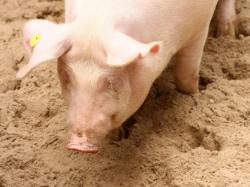Rabobank Report: PEDv Set To Cause Significant Shortfall In North American Hog Market
March 26, 2014 | 2 min to read

Porcine Epidemic Diarrhea Virus (PEDv) has impacted about 60% of the US breeding herd, 28% of the Mexican herd and is beginning to develop in Canada, according to Rabobank's latest report This Little Piggy Cried P-E-D-v All the Way Home: Estimating the Impacts of PEDv in North America. If PEDv spreads in Canada and Mexico at the pace seen in the US, North American hog slaughter could decline by nearly 18.5 million hogs over 2014 and 2014 or 12.5% relative to 2013 levels. Overall US pork production is anticipated to decline 6-7%, the most in more than 30 years.
"In the US we see the outbreak of PEDv causing a significant shortfall in the availability of market hogs in 2014 to the tune of 12.5 million hogs or 11% of annual slaughter," explained Rabobank Analyst William Sawyer. "Given the ever rising number of PEDv cases reported, coupled with a six-month average lifecycle, the months of August through October are likely to be the tightest for processors where slaughter could decline by 15% – 25% against 2013 levels. If the virus continues at its current rate, the shortfall to US slaughter in 2014 could be as much as 15 million hogs."
The specific origin of PEDv in the US has not been definitively identified but comparison of strains of PEDv in the US have indicated a close relationship with strains in China. What is clear is that once the virus makes it into a region, it can spread quite easily and rapidly throughout an entire population. The most common avenue is on livestock and farm equipment that come into contact with hogs positive with PEDv or their faeces.
In regard to productivity, 2014 will be a story of "the haves and have-nots" where hog producers who experienced mild cases of PEDv, or none at all, could realize margins of over USD 60 per head, the highest calendar year average seen in Rabobank's 40-year record. Conversely, hog producers who have had difficulty eradicating the virus could suffer significant losses as the pain of the high fixed costs of modern hog production compounds prolonged periods of weak productivity.
Packers for the year to date have been in a 'haves' position as the fear of possible stockouts have pushed pork cutout prices up far faster than hog prices. The gross margin for packers reached USD 63 per head, up from USD 37 this time last year. Profitability is likely to wane in the spring and summer, as prices continue to climb, testing pork demand, and hog shortages force packers to idle plants.
The real winner in the PEDv situation, however, will be the US poultry industry. With US beef production forecast to decline by nearly 6% in 2014 which, coupled with Rabobank's estimate of 6-7% less pork production, implies an exceptional opportunity for the US chicken industry as the protein of last resort. US chicken production would have to rise by 8% to 9% to offset the shortfall from beef and pork, but a limited breeder flock and continued high demand for fertilized eggs from Mexico will keep supply growth restrained. As a result, Rabobank expect chicken prices and margins climb this spring and summer yielding a very favorable year for the US chicken industry.
For more information please contact the report's author:
Will Sawyer: william.sawyer@rabobank.com +1 212 916 7991
Source: Rabobank
